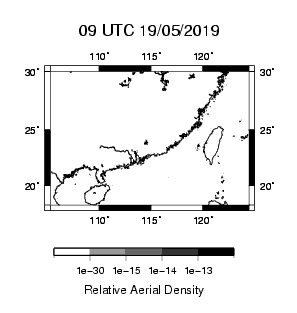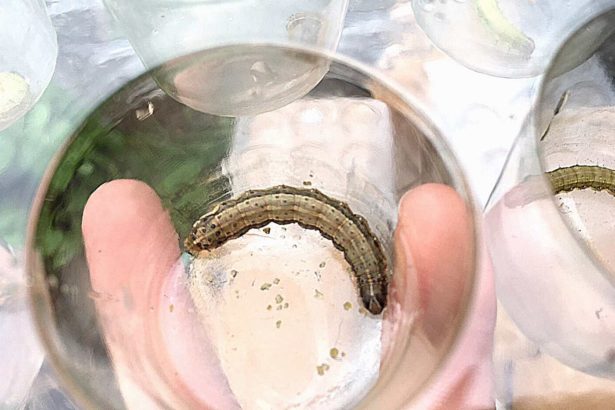(exclusive) how do autumn army insects fly in from China? Japan is on high alert and may have invaded Okinawa and Kyushu
277 share
Autumn military pests are rampant in Taiwan. according to the statistics of the emergency response team of the Council of Agriculture, as of yesterday (14), the larvae of autumn military insects in Taiwan had been identified by molecular and phenotypic identifications. with the exception of Nantou County, Kaohsiung City and Pingtung County, almost all of them were victimized, and adults of autumn military insects were also trapped in Matsu and Penghu on the outer islands.
Based on a model established with Japanese experts, experts from the Agricultural examination Institute of the Council of Agriculture estimate that this wave of autumn military insects may have endangered Okinawa, Japan, along with the wind and air currents, the Kyushu area of Japan may not be able to avoid disaster, and the Japanese side is on high alert as if it were in the face of an enemy. And because July is the typhoon season, both Japan and South Korea will face the threat of troops and insects riding on the wind in autumn.
Following the southwest airstream, the autumn army insects fly along the airstream across the Taiwan Strait
Where on earth did the autumn army insects come from? How to spread across Taiwan in a short period of time? There is a scattered flower-like distribution from south to north. The Council of Agriculture and the Bureau of Prevention and Inspection estimate that due to recent weather changes and the influence of the southwest airstream in southern China, the autumn army insects are also flying over the Taiwan Strait.
According to the data of the International Food and Agriculture Organization (FAO), the flying ability of the autumn army insect is very amazing, it can fly up to 100km in one night, and it can even reach 250km in an airstream, which is why South China has been ravaged by autumn army insects in 18 provinces in a short period of time.
Autumn army insects fly to Taiwan from Guangdong in mid-May, such as Tiannu scattered flowers covering the island
As a matter of fact, the Agricultural Test Institute of the Council of Agriculture has been working with plant epidemic prevention units in Japan through meteorological data and long-term monitoring of plant diseases and insect pests, especially those in central and southern China, especially in Guangdong and Fujian Province. cross the Strait to Taiwan, Okinawa and the four islands of Japan.
According to the National Research and Development Corporation of Agricultural and Food Industry Technology Integration Research Institute (NARO) of Japan, combined with the local distribution of autumn army insects in South China and the simulated data of meteorology and airflow, the instar days of the first case of autumn army insects found in Miaoli Flying cattle Ranch in Taiwan on June 8 are estimated that the first wave of autumn army insects to Taiwan is most likely to fly to Taiwan on May 19 and 22 respectively. He flew in from Guangdong, China, and landed in Taiwan on the 20th and 23rd.


Japanese plant epidemic prevention unit monitors white-backed planthopper, daily real-time monitoring data, data source: general association legal person Japan Plant Disease Prevention Association, agricultural testing institute.
The upstream and downstream entrusts the meteorologist to analyze, and the weather chart looks at the truth.
Do the autumn army insects really come by the wind? How can the actual meteorological data in Taiwan be corroborated? Upstream and downstream commissioned meteorologist Peng Qiming for cartographic analysis. Over the past month, it is true that every week there has been a strong, warm and humid southwest airstream blowing from South China of the Chinese mainland to Taiwan. Peng Qiming also said that previously, when studying the Mongolian sandstorm blowing to Taiwan, it was found that bacteria and other "biological sources" came to Taiwan.
Peng Qiming also further explained the meteorological data for a few days before and after 20 May. At that time, there were indeed two or three waves of strong southwest air currents. The cloud system developed from Guangdong and Fujian approached Taiwan, moving eastward and southward all the way over Taiwan. The frontal cloud system moved southward with northeasterly winds, bringing warm and humid water vapor, and even torrential rain fell all over Taiwan.
From May 15 to May 31 and May 15 to yesterday (June 14), through the satellite weather images collected by the Japanese sunflower 8 satellite, we can also find that the white and blue cloud and rain bands have changed. it is true that this month's strong southwest airstream is coming from South China, bringing not only heavy rainfall, but also helping the autumn army worms to fly across the sea to Taiwan. Resulting in the distribution of scattered flowers in the whole station (please press to play the film).
From May 15 to May 31, satellite cloud images of Taiwan and South China, Japan and South Korea were produced by Weather risk Development Company.
From May 15 to June 14, satellite cloud images of Taiwan and South China, Japan and South Korea were produced by Weather risk Development Company.
Through the analysis of satellite meteorological cloud images, it also seems that it does not rule out the possibility that through this month's exuberant southwest airstream, autumn military insects are flying in from southern China, and Taiwan seems to have to accept the fact that autumn military insects have become endemic diseases. it is necessary to have a long-term plan for continuous epidemic prevention with them. after all, when the autumn military insects come out, there is no grass!
(to read more autumn army and insect news, please click here.)
- Prev

Autumn Army Worm 0612 Autumn Army Worm Spreads, Yilan Jiayi Confirmed, Suspected Cases Appear in South Australia
Autumn Army Worm 0612 Autumn Army Worm Spreads, Yilan Jiayi Confirmed, Suspected Cases Appear in South Australia
- Next

Matters needing attention in poultry breeding: strengthening the healthy feeding of poultry and the development trend of antibiotic substitutes
In the past decade, scientists have found that poor intestinal bacteria are related to many diseases, so how to increase intestinal probiotics has become a topic for scientists to study. In fact, intestinal health is also very important for livestock, in order to reduce the use of antibiotics. Recently, Ilan University
Related
- A course of planting techniques and methods on how to grow carrots
- How to plant the latest tulips?
- Is it better to pick tea in the morning or in the afternoon? When is the best time for tea to be picked? what is the third or fifth tea?
- Launch Yuanxiao Happy combination Haocha + Tea Yuan healthy Taste
- Penghu Tourism "Fireworks 20 Parade with You"
- 2022 West Lake Happiness holds "Digital Revitalization Voucher" and draws iphone13 and laptop.
- Banqiao Fuzhou social houses are designed to change start-up combined with police elimination to create a safe and livable environment
- The convenient measure of "mechanical weeding" in Xinbei has been abused and the Agriculture Bureau has imposed heavy penalties on the illegal land consolidation.
- Changgeng University Joins Hands with Four Memory Factories to Rescue Memory Talent Shortage
- The list of Taiwan's top 100 MVP managers is listed by the Director-General of the Farmers' Association of Sanxia District.

